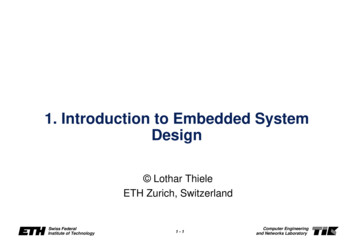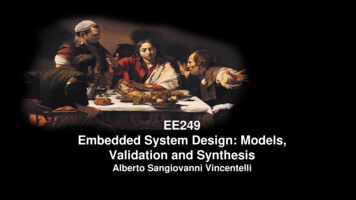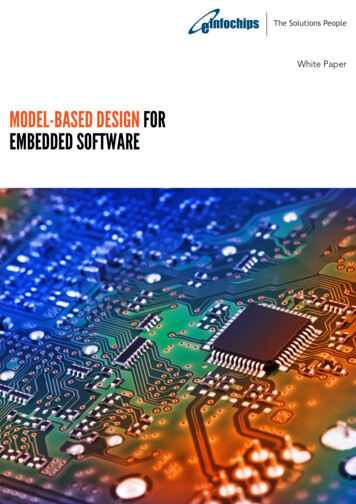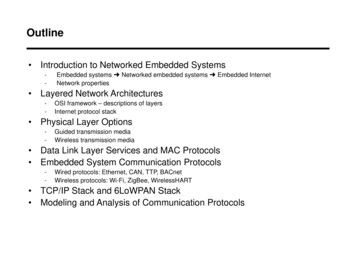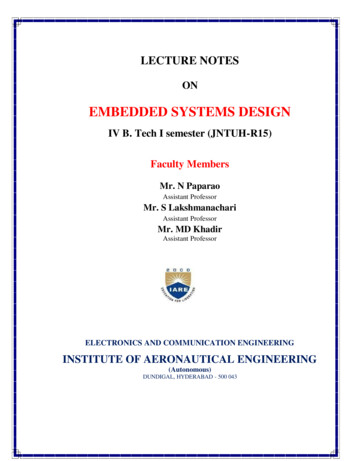
Transcription
LECTURE NOTESONEMBEDDED SYSTEMS DESIGNIV B. Tech I semester (JNTUH-R15)Faculty MembersMr. N PaparaoAssistant ProfessorMr. S LakshmanachariAssistant ProfessorMr. MD KhadirAssistant ProfessorELECTRONICS AND COMMUNICATION ENGINEERINGINSTITUTE OF AERONAUTICAL ENGINEERING(Autonomous)DUNDIGAL, HYDERABAD - 500 043
Embedded Systems DesignLECTURE NOTESSYLLABUS:Unit-IIntroduction to Embedded Systems:Definition of Embedded System, Embedded Systems Vs General Computing Systems, Historyof Embedded Systems,Classification, Major Application Areas, Purpose of EmbeddedSystems, Characteristics and Quality Attributes of Embedded Systems.UNIT-IITypical Embedded System:Core of the Embedded System: General Purpose and Domain Specific Processors, ASICs,PLDs, Commercial Off-The-Shelf Components (COTS), Memory: ROM, RAM, Memoryaccording to the type of Interface, Memory Shadowing, Memory selection for EmbeddedSystems, Sensors and Actuators, Communication Interface: Onboard and ExternalCommunication Interfaces.UNIT-IIIEmbedded Firmware:Reset Circuit, Brown-out Protection Circuit, Oscillator Unit, Real Time Clock, WatchdogTimer, Embedded Firmware Design Approaches and Development Languages.UNIT-IVRTOS Based Embedded System Design:Operating System Basics, Types of Operating Systems, Tasks, Process and Threads,Multiprocessing and Multitasking, Task Scheduling.UNIT- VTask Communication:Shared Memory, Message Passing, Remote Procedure Call and Sockets, Task Synchronization:Task Communication Synchronization Issues, Task Synchronization Techniques, DeviceDrivers, How to Choose an RTOS.TEXT BOOKS:1. Introduction to Embedded Systems - Shibu K.V, Mc Graw Hill.REFERENCE BOOKS:1. Embedded Systems - Raj Kamal, TMH.2. Embedded System Design - Frank Vahid, Tony Givargis, John Wiley.3. Embedded Systems – Lyla, Pearson, 20134. An Embedded Software Primer - David E. Simon, Pearson Education.
UNIT -IIntroduction to Embedded systemsINTRODUCTION: An embedded system is an electronic system, which includes a single chip microcomputers(Microcontrollers) like the ARM or Cortex or Stellaris LM3S1968. It is configured to perform a specific dedicated application. An embedded system is some combination of computer hardware and software, either fixed incapability or programmable, that is designed for a specific function or for specific functions withina larger system. Here the microcomputer is embedded or hidden inside the system. Every embeddedmicrocomputer system accepts inputs, performs computations, and generates outputs and runs in―real time.‖Ex: Cell phone, Digital camera, Microwave Oven, MP3 player, Portable digital assistant & automobileantilock brake system Industrial machines, agricultural and process industry devices, automobiles, medicalequipment, household appliances, airplanes, vending machines and toys as well as mobile devices are allpossible locations for an embedded system.etc.Characteristics of an Embedded System: The important characteristics of an embedded system are Speed (bytes/sec) : Should be high speed Power (watts) : Low power dissipation Size and weight : As far as possible small in size and low weight Accuracy (% error) : Must be very accurate Adaptability: High adaptability and accessibility. Reliability: Must be reliable over a long period of time.So, an embedded system must perform the operations at a high speed so that it can be readily used forreal time applications and its power consumption must be very low and the size of the system should be asfor as possible small and the readings must be accurate with minimum error. The system must be easilyadaptable for different situations.
CATEGORIES OF EMBEDDED SYSTEMS: Embedded systems can be classified into the following 4categories based on their functional and performance requirements.Embedded systemFunctional performanceStand alone embedded systemsReal time embedded systema) Hard real time E.Sb) Soft Real time E.SNetworked embedded systemMobile embedded systemsmall scale embedded systemmedium scale embedded s/mlarge scale embedded system.Stand alone Embedded systems:A stand-alone embedded system works by itself. It is a self-contained device which does not requireany host system like a computer. It takes either digital or analog inputs from its input ports, calibrates,converts, and processes the data, and outputs the resulting data to its attached output device, which eitherdisplays data, or controls and drives the attached devices.EX:Temperature measurement systems, Video game consoles, MP3 players, digital cameras, andmicrowave ovens are the examples for this category.Real-time embedded systems:An embedded system which gives the required output in a specified time or which strictly followsthe time deadlines for completion of a task is known as a Real time system. i.e. a Real Time system , inaddition to functional correctness, also satisfies the time constraints .There are two types of Real time systems. (i) Soft real time system and (ii) Hard real time system. Soft Real-Time system: A Real time system in which, the violation of time constraints will causeonly thedegraded quality, but the system can continue to operate is known as a Soft real timesystem. In soft real-time systems, the design focus is to offer a guaranteed bandwidth to each realtime task and to distribute the resources to the tasks.Ex: A Microwave Oven, washing machine, TV remote etc.
Hard Real-Time system: A Real time system in which, the violation of time constraints will causecritical failure and loss of life or property damage or catastrophe is known as a Hard Real t imesystem.These systems usually interact directly with physical hardware instead of through a human being .Thehardware and software of hard real-time systems must allow a worst case execution (WCET) analysis thatguarantees the execution be completed within a strict deadline. The chip selection and RTOS selectionbecome important factors for hard real-time system design.Ex: Deadline in a missile control embedded system , Delayed alarm during a Gas leakage , car airbagcontrol system , A delayed response in pacemakers ,Failure in RADAR functioning etc.Networked embedded systems:The networked embedded systems are related to a network with network interfaces to access theresources. The connected network can be a Local Area Network (LAN) or a Wide Area Network (WAN), orthe Internet. The connection can be either wired or wireless.The networked embedded system is the fastest growing area in embedded systems applications. Theembedded web server is such a system where all embedded devices are connected to a web server and canbe accessed and controlled by any web browser.Ex: A home security system is an example of a LAN networked embedded system where all sensors (e.g.motion detectors, light sensors, or smoke sensors) are wired and running on the TCP/IP protocol.Mobile Embedded systems:The portable embedded devices like mobile and cellular phones, digital cameras, MP3 players, PDA(Personal Digital Assistants) are the example for mobile embedded systems. The basic limitation of thesedevices is the limitation of memory and other resources.Based on the performance of the Microcontroller they are also classified into (i) Small scaledembedded system (ii) Medium scaled embedded system and (iii) Large scaled embedded system.Small scaled embedded system:An embedded system supported by a single 8–16 bit Microcontroller with on-chip RAM and ROMdesigned to perform simple tasks is a Small scale embedded system.Medium scaled embedded system:An embedded system supported by 16–32 bit Microcontroller /Microprocessor with external RAM
and ROM that can perform more complex operations is a Medium scale embedded system.Large scaled embedded system:An embedded system supported by 32-64 bit multiple chips which can perform distributed jobs isconsidered as a Large scale embedded system.Application Areas of Embedded Systems:The embedded systems have a huge variety of application domains which varies from very low costto very high cost and from daily life consumer electronics to industry automation equipments, fromentertainment devices to academic equipments, and from medical instruments to aerospace and weaponcontrol systems. So, the embedded systems span all aspects of our modern life. The following table givesthe various applications of embedded systems.Embedded SystemHome AppliancesOffice nicationAutomobileEntertainmentAerospaceIndustrial automationPersonalMedicalBanking & FinanceMiscellaneous:ApplicationDishwasher, washing machine, microwave, Top-set box,security system , HVAC system, DVD, answering machine,garden sprinkler systems etc.Fax, copy machine, smart phone system, modern, scanner,printers.Face recognition, finger recognition, eye recognition, buildingsecurity system , airport security system, alarm system.Smart board, smart room, OCR, calculator, smart cord.Signal generator, signal processor, power supplier,Processinstrumentation,Router, hub, cellular phone, IP phone, web cameraFuel injection controller, anti-locking brake system, air-bagsystem, GPS, cruise control.M P3, video game, Mind Storm, smart toy.Navigation system, automatic landing system, flight attitudecontroller, space explorer, space robotics.Assembly line, data collection system, monitoring systems onpressure, voltage, current, temperature, hazard detectingsystem, industrial robot.PDA, iPhone, palmtop, data organizer.CT scanner, ECG , EEG , EMG ,MRI, Glucose monitor,blood pressure monitor, medical diagnostic device.ATM, smart vendor machine, cash register ,Share marketElevators, tread mill, smart card, security door etc.Overview of embedded systems architecture:
Every embedded system consists of customer-built hardware components supportedby a CentralProcessing Unit (CPU), which is the heart of a microprocessor (µP) or microcontroller (µC). A microcontroller is an integrated chip which comes with built-in memory, I/O ports, timers, andother components. Most embedded systems are built on microcontrollers, which run faster than a custom-built systemwith a microprocessor, because all components are integrated within a single chip. Operating system plays an important role in most of the embedded systems. But all the embeddedsystems do not use the operating system. The systems with high end applications only use operating system. To use the operating system theembedded system should have large memory capability. So, this is not possible in low end applications like remote systems, digital cameras, MP3 players,robot toys etc. The architecture of an embedded system with OS can be denoted by layered structure as shownbelow. The OS will provide an interface between the hardware and application software.In the case of embedded systems with OS, once the application software is loaded into memory itwill run the application without any host system.Coming to the hardware details of the embedded system, it consists of the following important blocks. CPU(Central Processing Unit)
RAM and ROM I/O Devices Communication Interfaces Sensors etc. (Application specific circuitry)This hardware architecture can be shown by the following block diagram.Fig: hardware architecture of embedded systemCentral Processing Unit: A CPU is composed of an Arithmetic Logic Unit (ALU), a Control Unit (CU), and many internalregisters that are connected by buses. The ALU performs all the mathematical operations (Add, Sub, Mul, Div), logical operations (AND,OR), and shifting operations within CPU. The timing and sequencing of all CPU operations are controlled by the CU, which is actually built ofmany selection circuits including latches and decoders. The CU is responsible for directing the flowof instruction and data within the CPU and continuously running program instructions step by step. The CPU works in a cycle of fetching an instruction, decoding it, and executing it, known as thefetch-decode-execute cycle. For embedded system design, many factors impact the CPU selection, e.g., the maximum size(number of bits) in a single operand for ALU (8, 16, 32, 64 bits), and CPU clock frequency fortiming tick control, i.e. the number of ticks (clock cycles) per second in measures of MHz CPU contains the core and the other components which support the core to execute programs.Peripherals are the components which communicate with other systems or physical world (Likeports, ADC,DAC, Watch dog Timers etc.). The core issystem bus.separated from other components by the
The CPU in the embedded system may be a general purpose processor like a microcontroller or aspecial purpose processor like a DSP (Digital signal processor). But any CPU consists of of anArithmetic Logic Unit (ALU), a Control Unit (CU), and many internal registers that are connectedby buses. The ALU performs all the mathematical operations (Add, Sub, Mul, Div), logicaloperations (AND, OR), and shifting operations within CPU. There are many internal registers in the CPU. The accumulator (A) is a special data register that stores the result of ALU operations. It can alsobe used as an operand. The Program Counter (PC) stores the memory location of the next instructionto be executed. The Instruction Register (IR) stores the current machine instruction to be decodedand executed. The Data Buffer Registers store the data received from the memory or the data to be sent to memory.The Data Buffer Registers are connected to the data bus. The Address Register stores the memory location of the data to be accessed (get or set). The AddressRegister is connected to the address bus. In an embedded system, the CPU may never stop and run forever .The CPU works in a cycle offetching an instruction, decoding it, and executing it, known as the fetch-decode-execute cycle. Thecycle begins when an instruction is fetched from a memory location pointed to by the PC to the IRvia the data bus.When data and code lie in different memory blocks, then the architecture is referred as Harvardarchitecture. In case data and code lie in the same memory block, then the architecture is referred as VonNeumann architecture.
Von Neumann Architecture:The Von Neumann architecture was first proposed by a computer scientist John von Neumann. Inthis architecture, one data path or bus exists for both instruction and data. As a result, the CPU does oneoperation at a time. It either fetches an instruction from memory, or performs read/write operation on data.So an instruction fetch and a data operation cannot occur simultaneously, sharing a common bus.addressbusCPUdatabuscode &programmemoryVon-Neumann architecture supports simple hardware. It allows the use of a single, sequentialmemory. Today's processing speeds vastly outpace memory access times, and we employ a very fast butsmall amount of memory (cache) local to the processor.Harvard Architecture:The Harvard architecture offers separate storage and signal buses for instructions and data. Thisarchitecture has data storage entirely contained within the CPU, and there is no access to the instructionstorage as data. Computers have separate memory areas for program instructions and data using internaldata buses, allowing simultaneous access to both instructions and data.Programs needed to be loaded by an operator; the processor could not boot itself. In a Harvardarchitecture, there is no need to make the two memories share properties.Von-Neumann Architecture vs Harvard Architecture:PROGRAMMEMORYCPUCODEMEMORYThe following points distinguish the Von Neumann Architecture from the Harvard Architecture.
Von-Neumann ArchitectureHarvard ArchitectureSingle memory to be shared by both code and data.Separate memories for code and data.Processor needs to fetch code in a separate clock Single clock cycle is sufficient, ascycle and data in another clock cycle. So it separate buses are used to access coderequires two clock cycles.and data.Higher speed, thus less time consuming.Slower in speed, thus more timeconsuming.Simple in design.Complex in design.CISC and RISC: CISC is a Complex Instruction Set Computer. It is a computer that can address a large number ofinstructions. In the early 1980s, computer designers recommended that computers should use fewer instructionswith simple constructs so that they can be executed much faster within the CPU without having touse memory. Such computers are classified as Reduced Instruction Set Computer or RISC.CISC vs RISC:The following points differentiate a CISC from a RISC CISCRISCLarger set of instructions. Easy to programSmaller set of Instructions. Difficult toprogram.Simpler design of compiler, considering Complex design of compiler.larger set of instructions.Many addressing modes causing complex Few addressing modes, fix instructioninstruction formats.format.Instruction length is variable.Instruction length varies.Higher clock cycles per second.Low clock cycle per second.Emphasis is on hardware.Emphasis is on software.Control unit implements large instruction set Each instruction is to be executed byusing micro-program unit.hardware.Slower execution, as instructions are to be Faster execution, as each instruction is to beread from memory and decoded by the executed by hardware.decoder unit.
Pipelining is not ering single clock cycle.Mainly used in normal pc‘s, workstations & Mainly used for real time applications.servers.Memory: Embedded system memory can be either on-chip or off-chip. On chip memory access is much fast than off-chip memory, but the size of on-chip memory is muchsmaller than the size of off-chip memory. Usually, it takes at least two I/O ports as external address lines plus a few control lines such asR/W and ALE control lines to enable the extended memory. Generally the data is stored in RAMand the program is stored in ROM. The ROM, EPROM, and Flash memory are all read-only type memories often used to store code inan embedded system. The embedded system code does not change after the code is loaded into memory. The ROM is programmed at the factory and cannot be changed over time. The newer microcontrollers come with EPROM or Flash instead of ROM. Most microcontroller development kits come with EPROM as well. EPROM and Flash memory are easier to rewrite than ROM. EPROM is an Erasable ProgrammableROM in which the contents can be field programmed by a special burner and can be erased by a UVlight bulb. The size of EPROM ranges up to 32kb in most embedded systems. Flash memory is an Electrically EPROM which can be programmed from software so that thedevelopers don‘t need to physically remove the EPROM from the circuit to re-program it. It is much quicker and easier to re-write Flash than other types of EPROM. When the power is on, the first instruction in ROM is loaded into the PC and then the CPU fetchesthe instruction from the location in the ROM pointed to by the PC and stores it in the IR to start thecontinuous CPU fetch and execution cycle. The PC is advanced to the address of the nextinstruction depending on the length of the current instruction or the destination of the Jumpinstruction. The memory is divided into Data Memory and Code Memory.
Most of data is stored in Random Access Memory (RAM) and code is stored in Read Only Memory(ROM). This is due to the RAM constraint of the embedded system and the memory organization. The RAM is readable and writable, faster access and more expensive volatile storage, which can beused to store either data or code. Once the power is turned off, all information stored in the RAM will be lost. The RAM chip can be SRAM (static) or DRAM (dynamic) depending on the manufacturer. SRAMis faster than DRAM, but is more expensive.I/O Ports: The I/O ports are used to connect input and output devices. The common input devices for anembedded system include keypads, switches, buttons, knobs, and all kinds of sensors (light,temperature, pressure, etc). The output devices include Light Emitting Diodes (LED), Liquid Crystal Displays (LCD), printers,alarms, actuators, etc. Some devices support both input and output, such as communicationinterfaces including Network Interface Cards (NIC), modems, and mobile phones.Address LinesData LinesµpMemoryControl LinesInterfaceIn parallel I/O have two types of interfacing1. Memory mapped I/O2. I/O mapped I/O26
Memory Mapped IO IO is treated asmemory. 16-bit addressing. More DecoderHardware. Can address 216 64klocations. Less memory isavailable.IO Mapped IO IO is treated IO.8- bit addressing.Less Decoder Hardware.Can address 28 256locations. Whole memory addressspace is available.38
Memory Mapped IO Memory Instructionsare used. Memory controlsignals are used. Arithmetic and logicoperations can beperformed on data. Data transfer b/wregister and IO.IO Mapped IO Special Instructionsare used like IN, OUT. Special controlsignals are used. Arithmetic and logicoperations can notbe performed ondata. Data transfer b/waccumulator and IO.39Communication Interfaces: To transfer the data or to interact with other devices, the embedded devices are provided the variouscommunication interfaces like RS232, RS422, RS485 ,USB, SPI(Serial Peripheral Interface ) ,SCI(Serial Communication Interface) ,Ethernet etc.Application Specific Circuitry: The embedded system sometimes receives the input from a sensor or actuator. In such situationscertain signal conditioning circuitry is needed. This hardware circuitry may contain ADC, Op-amps,DAC etc. Such circuitry will interact with the embedded system to give correct output.ADC & DAC: Many embedded system application need to deal with non-digital external signals such as electronicvoltage, music or voice, temperature, pressures, and many other signals in the analog form. The digital computer does not understand these data unless they are converted to digital formats.The ADC is responsible for converting analog values to binary digits. The DAC is responsible for outputting analog signals for automation controls such as DC motor orHVDC furnace control.In addition to these peripherals, an embedded system may also have sensors, Display modules like LCD orTouch screen panels, Debug ports certain communication peripherals like I 2C, SPI, Ethernet, CAN, USB forhigh speed data transmission. Now a days various sensors are also becoming an important part in the designof real time embedded systems. Sensors like temperature sensors, light sensors, PIR sensors, gas sensors arewidely used in application specific circuitry.Address bus and data bus:
According to computer architecture, a bus is defined as a system that transfers data betweenhardware components of a computer or between two separate computers. Initially, buses were made up using electrical wires, but now the term bus is used more broadly toidentify any physical subsystem that provides equal functionality as the earlier electrical buses. Computer buses can be parallel or serial and can be connected as multidrop, daisy chain or byswitched hubs. System bus is a single bus that helps all major components of a computer to communicate with eachother. It is made up of an address bus, data bus and a control bus. The data bus carries the data to bestored, while address bus carries the location to where it should be stored.Address Bus Address bus is a part of the computer system bus that is dedicated for specifying a physical address. When the computer processor needs to read or write from or to the memory, it uses the address busto specify the physical address of the individual memory block it needs to access (the actual data issent along the data bus). More correctly, when the processor wants to write some data to the memory, it will assert the writesignal, set the write address on the address bus and put the data on to the data bus. Similarly, when the processor wants to read some data residing in the memory, it will assert the readsignal and set the read address on the address bus. After receiving this signal, the memory controller will get the data from the specific memory block(after checking the address bus to get the read address) and then it will place the data of the memoryblock on to the data bus.The size of the memory that can be addressed by the system determines the width of the data busand vice versa. For example, if the width of the address bus is 32 bits, the system can address 232 memoryblocks (that is equal to 4GB memory space, given that one block holds 1 byte of data).Data Bus A data bus simply carries data. Internal buses carry information within the processor, while externalbuses carry data between the processor and the memory. Typically, the same data bus is used for both read/write operations. When it is a write operation, theprocessor will put the data (to be written) on to the data bus. When it is the read operation, the memory controller will get the data from the specific memoryblock and put it in to the data bus.What is the difference between Address Bus and Data Bus?
Data bus is bidirectional, while address bus is unidirectional. That means data travels in bothdirections but the addresses will travel in only one direction. The reason for this is that unlike the data, the address is always specified by the processor. Thewidth of the data bus is determined by the size of the individual memory block, while the width ofthe address bus is determined by the size of the memory that should be addressed by the system.Power supply: Most of the embedded systems now days work on battery operated supplies. Because low power dissipation is always required. Hence the systems are designed to work withbatteries.Clock: The clock is used to control the clocking requirement of the CPU for executing instructions and theconfiguration of timers. For ex: the 8051 clock cycle is (1/12)10-6 second (1/12µs) because theclock frequency is 12MHz. A simple 8051 instruction takes 12 cycles (1ms) to complete. Of course,some multi-cycle instructions take more clock cycles. A timer is a real-time clock for real-time programming. Every timer comes with a counter which canbe configured by programs to count the incoming pulses. When the counter overflows (resets tozero) it will fire a timeout interrupt that triggers predefined actions. Many time delays can begenerated by timers. For example ,a timer counter configured to 24,000 will trigger the timeoutsignal in 24000x 1/12µs 2ms. In addition to time delay generation, the timer is also widely used in the real-time embedded systemto schedule multiple tasks in multitasking programming. The watchdog timer is a special timingdevice that resets the system after a preset time delay in case of system anomaly. The watchdogstarts up automatically after the system power up. One need to reboot the PC now and then due to various faults caused by hardware or software. Anembedded system cannot be rebooted manually, because it has been embedded into its system. Thatis why many microcontrollers come with an on-chip watchdog timer which can be configured justlike the counter in the regular timer. After a system gets stuck (power supply voltage out of range orregular timer does not issue timeout after reaching zero count) the watchdog eventually will restartthe system to bring the system back to a normal operational condition.Application Specific software:
It sits above the O.S. The application software is developed according to the features of thedevelopment tools available in the OS.These development tools provide the function calls to access the services of the OS. These functioncalls include, creating a task ,to read the data from the port and write the data to the memory etc.The various function calls provided by an operating system arei.To create ,suspend and delete tasks.ii.To do task scheduling to providing real time environment.iii.To create inter task communication and achieve the synchronization between tasks.iv.To access the I/O devices.v.To access the communication protocol stack .The designer develops the application software based on these function calls.Recent trends in Embedded systems : With the fast developments in semiconductor industry andVLSI technology ,one can find tremendous changes in the embedded system design in terms of processorspeed , power , communication interfaces including network capabilities and software developments likeoperating systems and programming languages etc. Processor speed and Power : With the advancements in processor technology ,the embeddedsystems are now days designed with 16,32 bit processors which can work in real time environment.These processors are able to perform high speed signal processing activities which resulted in thedevelopment of high definition communication devices like 3G mobiles etc.Also the recentdevelopments in VLSI technology has paved the way for low power battery operated devices whichare very handy and have high longevity. Also, the present day embedded systems are providedwith higher memory capabilities ,so that most of them are based on tiny operating systems likeandroid etc. Communication interfaces : Most of the present day embedded systems are aimed at internet basedapplications. So,the communication interfaces like Ethernet, USB, wireless LAN etc.have becomevery common resources in almost all the embedded systems. The developments in memorytechnologies also helped in porting the TCP/IP protocol stack and the HTTP server software on tothe embedded systems. Such embedded systems can provide a link between any two devicesanywhere in the globe. Operating systems : With recent software developments ,there is a considerable growth in theavailability of operating systems for embedded systems. Mainly new operating systems aredeveloped which can be used in real time applications. There are both commercial RTOSes like Vx
Works , QNX,WIN-CE and open source RTOSes like RTLINUX etc. The Android OS in mobileshas revolutionized the
For embedded system design, many factors impact the CPU selection, e.g., the maximum size (number of bits) in a single operand for ALU (8, 16, 32, 64 bits), and CPU clock frequency for timing tick control, i.e. the number of ticks (clock cycles) per second in measures of MHz CPU contains the






